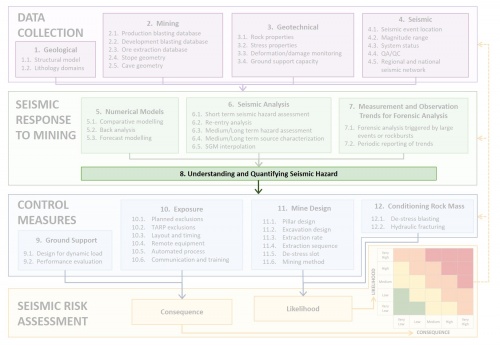8. Understanding and Quantifying Seismic Hazard

This step of the seismic management process not only looks at the current hazard, but also looks forward and provides prognostics of the probable seismic response to the mining plan. Most seismically-active mines have a process to assess the seismic hazard in the short (days) and on the medium (weeks/months), and long (months/years) term. However, the processes applied vary between mines. For the standard practices, whether it is short-, medium- or long-term hazard, the understanding and quantification of seismic hazard relies almost exclusively on simple seismological analyses as described in Section 6.
The advanced practices use a combination of numerical modelling and seismic source parameter analyses and relate them to local knowledge from forensic and periodic back analyses to assess the current hazard and forecast the medium/long term hazard.
The responsibility to produce seismic hazard assessments and forecasts is often delegated to seismology consultants. In other cases, the responsibility of identifying, understanding and quantifying the seismic hazard in the mine is delegated to skilled numerical modelling experts. Both of the above can contribute to better understand the seismic hazard, but neither the expert seismologists or numerical modelling specialists in isolation have the intimate day-to-day knowledge of the rock mechanics/seismic response of the mine to make a reliable interpretation.
It is, therefore, very important to realise that seismic hazard assessment and forecasting can only be properly interpreted once a clear understanding of how the seismic sources in the mines have responded to mining in the past. This can be further complicated when the interaction between different seismic sources occurs, which is common in most mature seismically-active mines.
The benchmarking exercise has revealed that very few mines have adopted the advanced practice of integrating advanced numerical modelling, numerous seismological techniques with an in depth analysis of forensic and periodic trends to develop the understanding require to produce confident forecasting of medium- and long-term seismic hazard.
Kidd mines provide a good example of such an advanced process. They rely on a mine-wide elasto-plastic numerical model which has been calibrated using seismic and displacement data over many years. Prognostics from the numerical model are done regularly and up-dated every time the prediction does not match the seismic or displacement response. The seismic hazard is quantified based on multiple seismological techniques including time series analysis, statistical analysis and grid-based spatial analysis. These different analyses are applied using different seismic parameters including: event frequency, magnitude, Energy Index, Apparent stress and Apparent volume. The seismic hazard is defined and monitored continuously. Control measures are applied accordingly and reviewed periodically by considering all of the above techniques. Trends and history are well documented.

